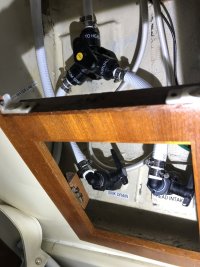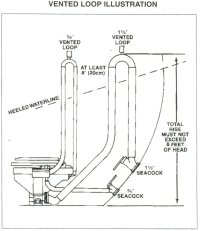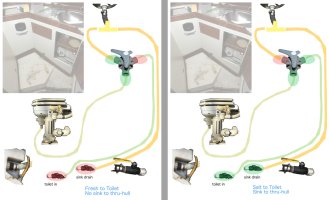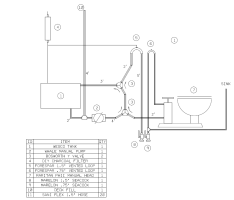Salt flush for any cruise. If the head gets pumped every day, no issue with organic material smell.
-
Untitled Document Join us on November 22nd, 7pm EDT
for the CBEC Virtual Meeting
Adventures & Follies
All EYO members and followers are welcome to join the fun and get to know the people you've met online!
See the link below for login credentials and join us!
(dismiss this notice by hitting 'X', upper right)
You are using an out of date browser. It may not display this or other websites correctly.
You should upgrade or use an alternative browser.
You should upgrade or use an alternative browser.
Head (toilet) Hose Connections Ericson 381
- Thread starter Christian Williams
- Start date
Marlin Prowell
E34 - Bellingham, WA
We replaced the hoses and original Ericson Y valves with a single Y valve configuration that allows both fresh water and sea water flush. The original Ericson system had problems which I won’t repeat here.
The line labeled From Sink and the thruhull line labeled Sink Drain both lead to a Tee fitting directly underneath the sink drain. The Y valve is set in the photo to send sea water to the toilet. To use the sink, open the Sink Drain thruhull valve.
To send fresh water to the toilet, switch the Y valve to connect the From Sink hose to the To Head hose And close the Sink Drain thruhull. Fresh water in the sink bowl will now be drawn into the toilet bowl when the toilet is pumped.
The toilet outlet leads directly to the holding tank — no Y valves there any more.
When we are out cruising, we use sea water for flushing. When we return, we pump the holding tank. We then pump lots of fresh water from the sink through the toilet and into the holding tank, and pump the holding tank again. We don’t have any head odors at all.

The line labeled From Sink and the thruhull line labeled Sink Drain both lead to a Tee fitting directly underneath the sink drain. The Y valve is set in the photo to send sea water to the toilet. To use the sink, open the Sink Drain thruhull valve.
To send fresh water to the toilet, switch the Y valve to connect the From Sink hose to the To Head hose And close the Sink Drain thruhull. Fresh water in the sink bowl will now be drawn into the toilet bowl when the toilet is pumped.
The toilet outlet leads directly to the holding tank — no Y valves there any more.
When we are out cruising, we use sea water for flushing. When we return, we pump the holding tank. We then pump lots of fresh water from the sink through the toilet and into the holding tank, and pump the holding tank again. We don’t have any head odors at all.

Prairie Schooner
Jeff & Donna, E35-3 purchased 7/21
Peggy Hall recommends a vent loop, though I don't see them often in installations. When we got the boat last fall we'd find some sea water in the toilet bowl after sailing. Would a loop stop that? Are vent loops a nice improvement or is the absence of one a disaster waiting to happen?
Since EY was not installing them on either the head intake or outflow in 1988, I also wonder if any potential problem they might address is also worth some additional complication?
That said, I do have Peggy's book, and consider her to be a real 'authority' on this stuff.
That said, I do have Peggy's book, and consider her to be a real 'authority' on this stuff.
Last edited:
A vented loop keeps the toilet from overflowing when heeled over, and as I recall my 32-3, which didn;t have such a loop, would do that. I kept that thru-hull closed except when using the head.
I was always taught to keep the toilet seat up and the head door open except when in use, so you can notice an overflowing head. The habit is ingrained to this day.
I don't have a vented loop on the current boat, but have considered installing one. They look like this:

I was always taught to keep the toilet seat up and the head door open except when in use, so you can notice an overflowing head. The habit is ingrained to this day.
I don't have a vented loop on the current boat, but have considered installing one. They look like this:

Prairie Schooner
Jeff & Donna, E35-3 purchased 7/21
@Loren Beach @Christian Williams
Thanks guys. Helpful perspective. I'll get the basic gear put back in with the salt/fresh wyes and save the vented loop on for further down the list. But I'll have to make closing the thru-hull a new habit.
Thanks guys. Helpful perspective. I'll get the basic gear put back in with the salt/fresh wyes and save the vented loop on for further down the list. But I'll have to make closing the thru-hull a new habit.
RCsailfast
E35-3 Illinois
Our through hull valve, as shown in picture F, started to leak lake water where it attaches to the 90.
Then the top side of the valve was leaking pee. Not fun. Cleaned and taped both sides with 3M 23 rubber splicing tape. Thankfully fresh and foul liquids aren’t leaking under the sink anymore and smells are gone after a lot of cleaning. I know this is a temporary fix till we pull out for the winter. Is there a better solution with the boat still in the water?
Then the top side of the valve was leaking pee. Not fun. Cleaned and taped both sides with 3M 23 rubber splicing tape. Thankfully fresh and foul liquids aren’t leaking under the sink anymore and smells are gone after a lot of cleaning. I know this is a temporary fix till we pull out for the winter. Is there a better solution with the boat still in the water?
Frank Langer
1984 Ericson 30+, Nanaimo, BC
There is a product called Seal All, available at most hardware stores, very inexpensive, but does a good job of sealing, yet can be undone when necessary. I would add that on top of what you've done, just to help out.Our through hull valve, as shown in picture F, started to leak lake water where it attaches to the 90.
Then the top side of the valve was leaking pee. Not fun. Cleaned and taped both sides with 3M 23 rubber splicing tape. Thankfully fresh and foul liquids aren’t leaking under the sink anymore and smells are gone after a lot of cleaning. I know this is a temporary fix till we pull out for the winter. Is there a better solution with the boat still in the water?
Frank
RCsailfast
E35-3 Illinois
Still a very small leak on the valve but manageable with some rags and using the dehumidifier when docked.
Still wondering how the valve is attached to the elbow and hose fitting to the pump. The valve swivels on the elbow so feel glue is out of the question but don’t see threads. Makes me wonder if it’s a compression seal. With as small as the leak is at this point I don’t want to risk breaking anything or making it worse.
Still wondering how the valve is attached to the elbow and hose fitting to the pump. The valve swivels on the elbow so feel glue is out of the question but don’t see threads. Makes me wonder if it’s a compression seal. With as small as the leak is at this point I don’t want to risk breaking anything or making it worse.
Sorry for the tangent but I went to a Natures Head composter and never looked back. I could carry a YEARs worth of replacement (coco noir bricks) in about 1/3 the space of the nasty black water tank.
Which I never again have to flush,
Or smell,
Or deal with leaks, joker valves, pumps, . . .
And now that black water tank space is clean storage.
Which I never again have to flush,
Or smell,
Or deal with leaks, joker valves, pumps, . . .
And now that black water tank space is clean storage.
Prairie Schooner
Jeff & Donna, E35-3 purchased 7/21
I'd make a perfectly hopeless electrical engineer, evidenced by the fact that I needed to do a schematic just to figure this one out.We replaced the hoses and original Ericson Y valves with a single Y valve configuration that allows both fresh water and sea water flush. The original Ericson system had problems which I won’t repeat here.
The line labeled From Sink and the thruhull line labeled Sink Drain both lead to a Tee fitting directly underneath the sink drain. The Y valve is set in the photo to send sea water to the toilet. To use the sink, open the Sink Drain thruhull valve.
To send fresh water to the toilet, switch the Y valve to connect the From Sink hose to the To Head hose And close the Sink Drain thruhull. Fresh water in the sink bowl will now be drawn into the toilet bowl when the toilet is pumped.
. . .
When we are out cruising, we use sea water for flushing. When we return, we pump the holding tank. We then pump lots of fresh water from the sink through the toilet and into the holding tank, and pump the holding tank again. We don’t have any head odors at all.
@Marlin Prowell
Does this diagram represent what you did?

In addition to having fewer parts, it seems like it could discipline a crew to keep these thru-hulls closed unless they are needed. That's something Christian recommended and a habit we want to try to instill.
Thanks,
Jeff
(We're in the water with the original setup, but I want to do this sooner than later.)
Marlin Prowell
E34 - Bellingham, WA
@Prairie Schooner Your diagrams are correct. Your green bubbles show what is open and connected on the Y valve.
In a very passive voice, Forespar says on their website, “IT IS NOT RECOMMENDED TO INSTALL Y-VALVES BELOW THE WATERLINE”.
I attached a long clear hose to a thru-hull to determine the water level in the head and our Y-valve is above the water line. The rim of the toilet bowl is barely above the water line, so if a valve in the toilet pump failed when the thru-hull is open, it might just fill the toilet bowl and not sink the boat. We do make a habit of only opening the thru-hulls when needed because we don’t want to test that.
I plan on adding a vented loop between the toilet pump and the toilet bowl, but have not done it yet.
In a very passive voice, Forespar says on their website, “IT IS NOT RECOMMENDED TO INSTALL Y-VALVES BELOW THE WATERLINE”.
I attached a long clear hose to a thru-hull to determine the water level in the head and our Y-valve is above the water line. The rim of the toilet bowl is barely above the water line, so if a valve in the toilet pump failed when the thru-hull is open, it might just fill the toilet bowl and not sink the boat. We do make a habit of only opening the thru-hulls when needed because we don’t want to test that.
I plan on adding a vented loop between the toilet pump and the toilet bowl, but have not done it yet.
You can make this even easier by putting the T on the thru hull and removing the y valve. One side of the t goes to the sink drain and the other to the head pick up. When the thru hull is closed, the head draws from the sink, when it's open it draws raw water.
Interesting. I have not yet been on a sailboat with the Y valve(s) notably above the waterline.In a very passive voice, Forespar says on their website, “IT IS NOT RECOMMENDED TO INSTALL Y-VALVES BELOW THE WATERLINE”.
The rim of the toilet bowl
Yep, on my boat an open head seawater intake through hull valve fills the toilet bowl 4/5th full. Not good when heeled over.
Under normal circumstances it stays closed all the time, because I use fresh-water bowl fill from the sink, which is in effect a vented loop.
But offshore, when using salt water flush to conserve drinking water, I only open that valve when using the head.
Yep, on my boat an open head seawater intake through hull valve fills the toilet bowl 4/5th full. Not good when heeled over.
Under normal circumstances it stays closed all the time, because I use fresh-water bowl fill from the sink, which is in effect a vented loop.
But offshore, when using salt water flush to conserve drinking water, I only open that valve when using the head.
Prairie Schooner
Jeff & Donna, E35-3 purchased 7/21
Well, dang, Nick. Now I gotta make another schematic.You can make this even easier by putting the T on the thru hull and removing the y valve. One side of the t goes to the sink drain and the other to the head pick up. When the thru hull is closed, the head draws from the sink, when it's open it draws raw water.
@Marlin Prowell
Marlin, Thanks for including the bit about water level. That was on my mind, but I didn't want to make my post too long.
My sailing mentor often quotes Rule #1: "Nothing is easy." followed by Rule #2: "There are no exceptions to Rule #1".
Thanks again all,
Jeff
Just open the thru hull and the sink will drain.Well, dang, Nick. Now I gotta make another schematic.With that setup the question that comes to mind is how would I drain the sink outside the boat?
@Marlin Prowell
Marlin, Thanks for including the bit about water level. That was on my mind, but I didn't want to make my post too long.
My sailing mentor often quotes Rule #1: "Nothing is easy." followed by Rule #2: "There are no exceptions to Rule #1".
Thanks again all,
Jeff
This is what I ended up installing. We don't have a lot of use for the ability to pump the head or tank overboard in the Puget Sound, but I didn't want to remove the ability in the event we decide to do some off shore stuff in the future. So far it's working great and we haven't had the bowl fill up from leaving the thru hull open (a common event before the rework). We typically wash our hands with the drain thru hull closed, then flush with what's left in the sink. That way we end up using fresh water and it's not wasted.


Marlin Prowell
E34 - Bellingham, WA
Peggy Hall in The New Get Rid of Boat Odors mentions on page 52 using a Tee fitting on a combo sink drain/head intake thru-hull, saving one thru-hull.
She also adds, “It may be necessary to keep the sink plugged except when in use, with a rubber sink plug or by installing a conveniently located hut-off valve in the drain hose. Otherwise the toilet may pull air through the sink when you try to flush, preventing the pump from priming.”
I chose not to use a Tee fitting for this reason. I didn’t want to add additional complications for guests already struggling with unfamiliar plumbing.
She also adds, “It may be necessary to keep the sink plugged except when in use, with a rubber sink plug or by installing a conveniently located hut-off valve in the drain hose. Otherwise the toilet may pull air through the sink when you try to flush, preventing the pump from priming.”
I chose not to use a Tee fitting for this reason. I didn’t want to add additional complications for guests already struggling with unfamiliar plumbing.
Marlin Prowell
E34 - Bellingham, WA
@trickdhat I’m confused about one thing in your plumbing. Forespar vented loops have duckbill valves in them. When you pull sea water into the toilet pump, why doesn’t air get drawn into the plumbing through vented loop #6? In the diagram posted by Christian Williams, the vented loop is on the output side of the pump — between the pump and the toilet bowl. The hose from the toilet pump to the toilet bowl is not shown in your drawing.
